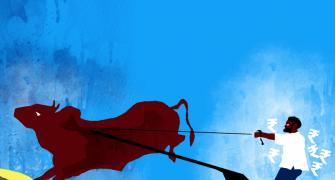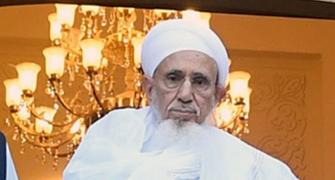While all the airlines have been looking at ways to cut costs, the low cost carriers (LCC) have been less affected by the slowdown due to their lower overheads and business model.
One such carrier is SpiceJet, the only listed LCC in the country. It's CEO, Sanjay Aggarwal, who was appointed three months ago, has his task cut out and would need every bit of his 17 years experience in the travel sector to pilot the airline to profitability.
In an interview to Ram Prasad Sahu he delves on the dynamics of the Indian aviation market, the fare wars and the outlook for SpiceJet over the next one year.
Fuel helped ease the pressure on costs in the December quarter. What's your call on the current quarter and when do you expect to break even?
You could expect a drop of about 3-4 per cent on the cost front due to ATF prices in this quarter. Our load factors in January at 68 per cent have not exactly gone through the roof while fares have fallen 40-50 per cent (At around Rs 2,000 levels, the airline needed more than 100 per cent load factors to break even).
Yes, it was a bad month, but we still did better as our fuel estimates were higher than what it turned out to be. At the current levels (Rs 3,900) we would need in the high 60s to break even. I think this year would be a year of zero growth. Demand would be similar to what we saw in 2008 and from the economic outlook scenario that is unfolding, demand would start to return late this year or sometime next year.
What has helped increase SpiceJet's market share in January?
While we have a 6.6 per cent of the domestic fleet, we have generated 11.8 per cent market share in January. Our strategy of focusing on building frequency on high-traffic routes has enabled us to build our market share. Our average weekly frequency in our top city-pairs is around 20 with nearly three daily flights.
Vis-à-vis other low-cost carriers how do you differentiate yourself and how are you planning to prune your costs?
Our aircraft utilisation is one of the best and that is the biggest piece. We have better on-time performance, our seats are more comfortable, we have more leg room and fewer cancellations due to mechanical failure, and our employees, we believe, are friendlier. I think there is differentiation, but is it enough for people to say I want to pay Rs 200 more to fly SpiceJet? I don't think the differentiation exists to that point.
On the cost side, we pay close attention to fuel efficiency, how much fuel we are burning, what we are carrying and where we are flying and look at all issues surrounding fuel efficiency. Finally, it is not just about costs it is also about revenue streams, which routes are you picking and are they profitable, are they giving good yields and loads for you. The topline matters more than what we could squeeze out of costs.
It terms of competitive challenges, what worries you the most?
The biggest challenge is the fare wars and there is no sanity there. There are times when you say on the back of a $100 million income a year, you want to invest $10 million to win market share. That is logical.
When you are losing $150 million and you are saying you would like to invest $20 million and you don't have anybody to fund the $150 million loss, it is called insanity. Doing this on top of accumulated losses doesn't make sense. The fare wars were completely irrational. When cutting fares and stimulating demand, you need to find the right balance or level between load factors and average fares (that makes sense for the airline).
What can be done to stimulate demand?
You have to rationalise the pricing and maintain that price. If I am a customer, I will not trust a pricing as this week it goes up, next week it may go down. You are never sure when to buy, as you keep waiting to get a good deal. Pricing has to be such that load factors would hover around 65-70 per cent so that we could break even and make money.
Then you have to stick around those fares. You can launch promotions and special offers once in a while for a day or two. But, if you drop the prices one day and raise it on another, customers keep postponing and by the time they decide to fly, prices have shot up. Some maturity needs to come to the rationalisation of the fares for the sector to succeed.
With the sector in doldrums, what's in it for the retail investors of SpiceJet?
There are three things you need to believe in. First is the long term future of aviation in India. Second, the LCC model and its future in India as we are value conscious consumers. Finally, is SpiceJet a well-run company in the Indian LCC space. Historically, investments in aviation are volatile and highly correlated with the economy so investors have to patient.
Unlike the US, which is mature market and at best will grow at 2-3 per cent even at good times, in India we are still scratching at the surface. The US has a 300 million population and thousands of planes, and though not as affluent, we in India have a 300 million big middle class but still there are only 350 airplanes.
For a business that is guzzling cash, do you have enough to outlast competition?
Since inception (May 2005), we have had about Rs 850 crore (Rs 8.45 billion) of accumulated losses, which is much less when compared with some of the other airlines. We are a zero-debt company and unless the economic climate changes in a significant way, this cash (investment in August by Bill Ross to the tune of Rs 345 crore) will last us for several years. We have set for ourselves a target of breaking even in FY10.
Do you see a new phase of consolidation happening in the sector?
The market I believe is only big enough for two airlines each in the full service and low cost carriers segments. Unlike other countries, we have an excellent train network, which is an affordable and reliable mode of travel.
The places where the industry would be the most successful are the North-South and East-West routes where it takes 2-3 days by trains to reach your destination.
Since 60 per cent of your passengers are from the leisure segment and this is a price sensitive market, would the focus in the current scenario shift to corporates?
A large part of domestic air travel continues to be driven by business needs - upwards of 75 per cent. Over the last two quarters we have seen an increase in our business travel mix from 42 per cent to 52 per cent and we see this consistently increasing.
This is driven by the fact that a large number of corporate and businesses are shifting over to LCCs driven by value, on-time performance an hassle-free experience. At the same time, we are looking at packages and hotel tie-ups to grow the leisure segment.








